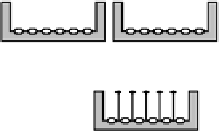Environmental Engineering Reference
In-Depth Information
must be resistant to all weather conditions and is made of aluminium or steel.
There is also a tendency to integrate solar collectors into south-facing walls. This
is especially interesting for solar combisystems (domestic hot water and space
heating) whose collector area for domestic hot water production is too big in sum-
mer, but which need as much solar irradiation in the heating season as possible.
Non-concentrating
liquid-type collectors
Non-concentrating
air collectors
Concentrating
collectors
Single absorbers
Single-passage type
Fixed
Concave
mirror
Evacuated
tube
Flat mirror
Blackenend over-
lapping glass panes
Flat-plate collectors
Air
Insulation
C
= 1...2
C
= 2...15
C
= 1...3
1 cover
2 covers
Single-axis tracking
Double-passage type
Vacuum flat-plate collector
Parabolic
trough
Flat mirror
field
Cylinder lens
Air ducts
Cover
support
Vacuum
tu
be collector
C
= 20...100
C
= 20...80
C
= 10...40
Glas cells / porous bed
Two-axis tracking
Heliostat field
Paraboloidal
Spherical
mirror
concave mirror
Storage collector
Glas cells
TIM
Absorber
Air
Porous bed
C
= 100...1,000
C
= 100...5,000
C
= 100...300
Stainless steel tank
Reflector
Fig. 4.4
Overview of different collector types (
C
concentration ratio; defined as the ratio of
the optically active collector area to the absorber area exposed to radiation; TIM transparent
insulation material; see e.g. /4-2/ and various other sources)
The storage collector (Fig. 4.4, left) is a special type of flat-plate collector. It
combines the collector and heat accumulation functionality in one component. A
pressure-resistant tank is installed in the centre of a radiation-focusing mirror. The
tank area is either selectively coated or painted in black. The storage collector is
directly connected with the cold and hot water pipes. The radiation on the collec-
tor is reflected onto the tank by the mirror; the water flowing through the tank
absorbs heat and can be used; sometimes a further heating is realised with other
sources of energy. Advantages of this design are the low number of components
and the compact design. A major disadvantage is the high convective thermal loss
that results in a significant temperature decrease inside the storage during the
night or bad weather. If installed on the roof, the weight of the water has to be
taken into account for the purpose of roof static's. Furthermore, ordinary tap wa-
ter normally flows through this collector; therefore there is a risk of frost due to
the meteorological conditions in Central and Northern Europe during the winter.
A further special type of liquid-type collector is the heat pipe, using the phase
change of a working medium that interchanges between evaporation and conden-

































Search WWH ::

Custom Search